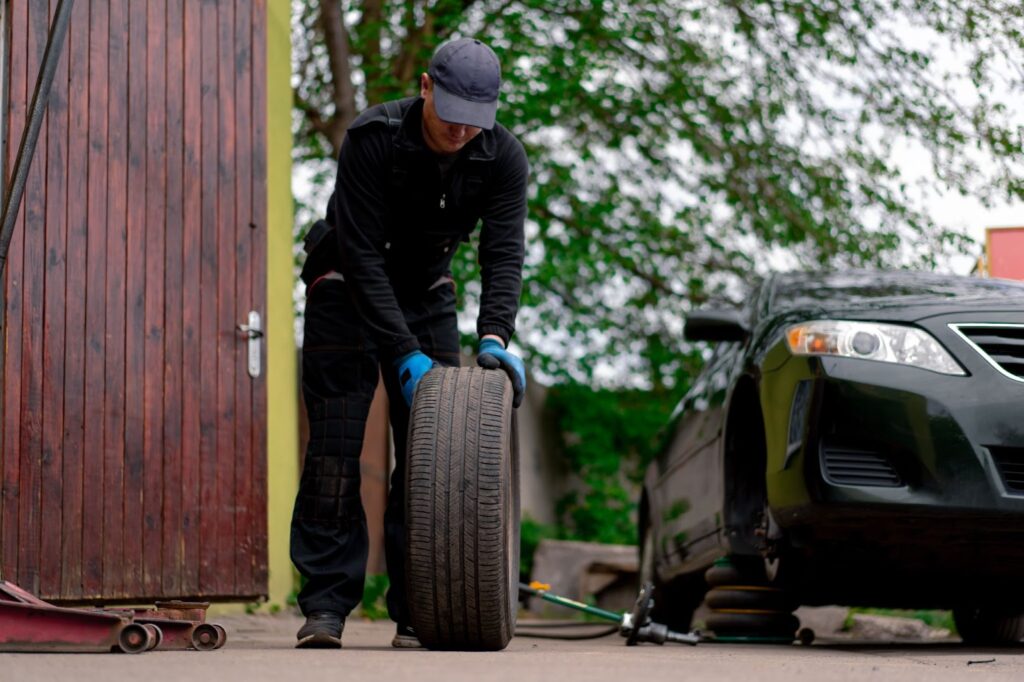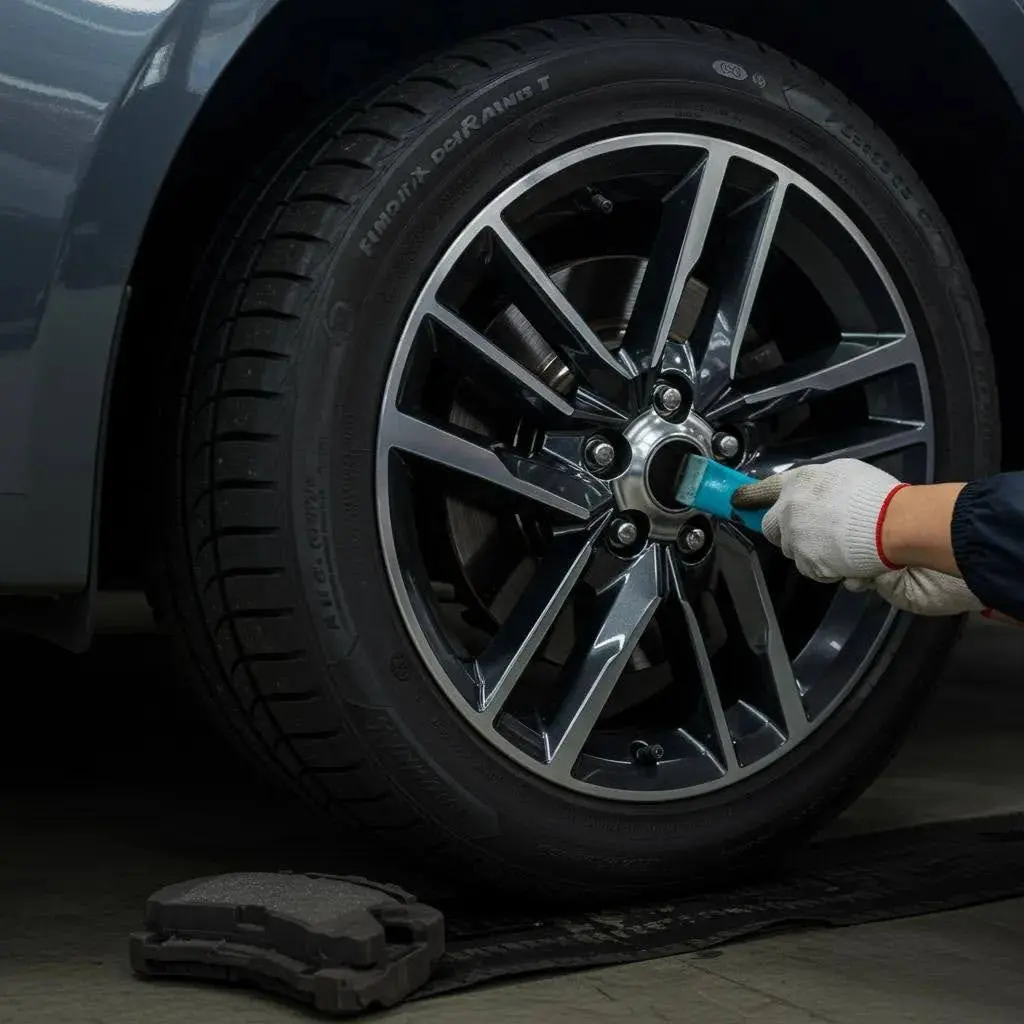Experiencing a tyre puncture is an almost inevitable aspect of driving. Whether it’s a nail or screw that has found its way into your tyre or a sudden sharp edge that slices through as you drive, the imperative question becomes: Can your tyre puncture be repaired, or is a replacement unavoidable?
This guide delves into the intricacies of car tyre puncture repair, addressing the critical factors that determine the feasibility of repairing a tyre, exploring the realm of run-flat tyres, and evaluating the effectiveness of tyre sealants and repair kits.
Understanding when a repair is possible can save time and money, not to mention ensuring your safety on the road.

What Determines if a Puncture Can Be Repaired?
Assessing the Size of the Puncture
The size of a puncture greatly influences whether a tyre can be repaired. Generally, punctures that are 6mm or less in diameter in the central ¾ of the tyre, known as the minor repair area, are considered repairable.
This is because the damage is small enough that a tyre puncture repair can restore the tyre’s integrity without compromising its safety. However, larger punctures or cuts signify more severe damage, making it unlikely the tyre can be repaired safely.
Location and Type of Tyre Damage
The location of the puncture also plays a crucial role in determining repairability. Damage to the tyre’s sidewall, for example, cannot typically be repaired due to the flexing and movement the sidewall undergoes, which could lead to a failed repair under pressure.
Similarly, a puncture in the tyre tread closer to the sidewall might fall outside the minor repair area, posing challenges to a safe repair. Also, the type of damage — whether it’s a clean puncture by a nail or screw or a larger gash — affects the repair process.
While a clean puncture might be fixable, more extensive damage usually requires tyre replacement.
Understanding the Tyre Repair Service Process
A comprehensive tyre repair involves more than just plugging the hole. A quality tyre repair service will assess the tyre’s general condition, remove it from the wheel to inspect for internal damage, and then decide on the best repair method.
Depending on the damage, this might be a patch, a plug, or a combination of both. The safety of the repair depends not only on the nature of the puncture but also on the condition of the tyre itself.
Are Run-Flat Tyres Repairable After a Puncture?
The Unique Design of Run-Flat Tyres
Run-flat tyres are designed to maintain their shape and offer support to the vehicle even after a puncture. This allows you to drive a limited distance at a reduced speed until you can reach a safe location for repair.
This capability comes from their reinforced sidewalls, which are significantly more robust than standard tyres.
Challenges with Repairing Run-Flat Tyres
Given their design, run-flat tyres pose challenges for repair. Driving on a punctured run-flat tyre can obscure damage, making it difficult to assess its extent accurately.
Run-flat tyres may suffer hidden internal damage from low air pressure, even if the exterior appears fine. This is why manufacturers often discourage permanent repairs on them. Additionally, the structural integrity of the tyre may be compromised even after a minor puncture, raising safety concerns about its repairability.
Manufacturer Recommendations for Run-Flat Tyre Puncture Repairs
Many manufacturers advise against repairing run-flat tyres after a puncture due to the potential unseen damage and the critical role the tyres play in vehicle safety.
However, suppose the puncture is in the minor repair area, and the tyre was not driven on extensively after the puncture. In that case, some specialists may consider a repair, always erring on the side of caution and closely following manufacturer guidelines.

How Do Tyre Sealants and Repair Kits Work?
The Role of Tyre Sealants in Emergency Repairs
Tyre sealants offer a temporary solution for tyre punctures. They are designed to seal the hole long enough for you to drive to a repair shop. They can be particularly useful for small, manageable punctures.
Although tyre sealants work in emergencies, they can interfere with professional repairs later on. They are not a permanent fix. Some experts recommend using a pre puncture sealant as a preventive measure instead..
Advantages and Limitations of Using a Puncture Repair Kit
A puncture repair kit typically includes tools and materials to seal a puncture from the outside temporarily. While these kits can be a convenient solution for minor punctures, they have limitations.
They may not work well for larger punctures or damage to the tyre’s sidewall and should be viewed as a stopgap measure until a professional repair can be completed.
An emergency tyre repair kit can be a lifesaver when you’re stranded without access to a garage. However, it’s not a substitute for inspection by a tyre specialist.
When to Choose a Professional Tyre Repair Service Over DIY
While DIY repair kits can sometimes save the day, professional tyre repair services are recommended to ensure a safe repair. Professionals have the tools, knowledge, and experience to thoroughly assess the puncture and perform repairs that maintain the tyre’s safety and integrity.
When in doubt, opting for a professional service is the safer bet, especially given the complexities that can surround tyre damage.
Attempting your own puncture repair without proper tools or knowledge can worsen the damage. Misaligning a repair patch or damaging the wheel rim may lead to more costly repairs
Understanding the Safety of Puncture Repairs
What Makes a Puncture Repair Safe?
A safe repair is one that fully restores the tyre to its original performance capabilities without compromising its structural integrity. This includes ensuring the repaired area is properly sealed, both internally and externally, and that the repair does not affect the tyre’s balance or performance.
A repair patch should be used according to British Standard BS AU 159 to ensure tyre puncture repairs are safe and long-lasting. Only when these standards are followed can a puncture be safely repaired without compromising performance.”
The overall condition of the tyre, including the tyre tread and tyre pressure, must also be considered to ensure ongoing safety.
The Importance of Tyre Pressure and Tyre Tread in Repaired Tyres
Maintaining the correct tyre pressure and monitoring tyre tread depth are crucial for the safety of repaired tyres. Proper pressure ensures the tyre performs optimally and wears evenly, while sufficient tread depth is essential for safe handling and braking.
Don’t forget to check the tyre valve, as a leaky valve can also cause a gradual loss of air pressure. Ensuring proper sealing at the valve can prevent premature tyre wear
Regular checks post-repair can catch any potential issues early, ensuring the longevity and safety of the tyre.
Long-Term Reliability of Repaired Tyres
When a tyre is properly repaired, its reliability should closely mirror that of an unrepaired tyre, provided the tyre was not excessively damaged and was repaired promptly and correctly. Regular inspections and maintenance can extend the life of the tyre and maintain its safety and performance.
Permanent repairs performed by trained technicians extend the life of your tyre while maintaining safety.
These repairs should follow strict guidelines and never exceed the manufacturer’s maximum speed recommendation.
Steps to Take When You Get a Puncture
How to Quickly Assess Whether the Tyre Can Be Repaired
Upon discovering a puncture, quickly assess the tyre for signs of severe damage, such as large cuts or deformations, and check whether the puncture is in the central ¾ of the tyre or the sidewall.
If the tyre wall is damaged or bulging, it is generally unsafe to repair and a replacement tyre should be installed. This is because sidewall integrity is critical for vehicle stability.
If the damage appears minimal, a repair may be possible.
Deciding Whether to Repair or Replace a Punctured Tyre
Deciding whether to repair or replace a tyre depends on the extent of the damage, the tyre’s age, and its tread depth. If the tyre is relatively new, with ample tread, and the puncture is small and located in the repairable area, the repair is feasible.
In some cases, a damaged tyre caused internal weakening that’s invisible from the outside. A tyre specialist can inspect for internal bruising near the wheel rim or inner liner.
However, older tyres or those with larger or more complex damage will likely require replacement.
How to Book a Puncture Repair with a Reliable Service Provider
When opting for professional repair, research local service providers to find one with excellent reviews and a reputation for quality work. Many providers offer the convenience of booking repairs online or via phone. Providing a detailed description of the puncture and your tyre will help them prepare for your visit, ensuring a swift and effective repair process.
If your spare tyre is in good condition, use it to get your vehicle to a service station. Never drive long distances on a space-saver spare or beyond its maximum speed rating.
Conclusion: Navigating the Path to Proper Tyre Puncture Repair
In the journey of understanding whether your car tyre puncture can be repaired and exploring the essential steps to take, we’ve armed you with critical knowledge to make informed decisions. From initial detection to considering factors like the size of the puncture, the location of the damage, and whether your vehicle is equipped with run-flat tyres, each aspect plays a pivotal role in determining the feasibility and safety of a tyre repair.
The use of tyre sealants, the importance of tyre pressure, and the availability of puncture repair kits have also been explored to provide you with comprehensive insights into managing tyre health effectively.
As we conclude our guide, remember that not all puncture repairs are created equal. Safety is paramount, and consulting with a professional tyre repair service is always advisable to ensure that your vehicle remains reliable on the road. Whether you’re dealing with a slow puncture, considering the use of tyre sealants, or debating if a puncture can be effectively repaired, the knowledge you’ve gained from this guide ensures you’re well-equipped to take the right steps toward maintaining your car’s tyres. With proper attention and care, you can extend the life of your tyres, ensuring a smoother, safer drive every time.


